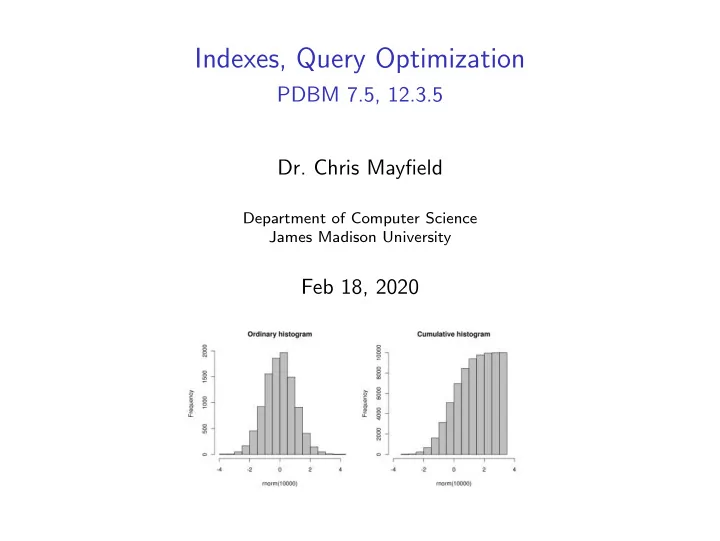

Indexes, Query Optimization PDBM 7.5, 12.3.5 Dr. Chris Mayfield Department of Computer Science James Madison University Feb 18, 2020
Part 1: SQL Indexes
How data is stored Heap File Index File (table: movie ) (column: movie.year ) RID id title year year RID 1 282375 Inception 2010 2009 4 2 293178 Jane Eyre 2011 2010 1 3 246720 Harry Potter 2010 2010 3 4 57126 Avatar 2009 2010 5 5 662387 TRON: Legacy 2010 2011 2 . . . . . . . . . . . . . . . . . . Does this query have to look at every movie? SELECT * FROM movie WHERE year >= 2011; Feb 18, 2020 Indexes, Query Optimization 3 of 18
Creating indexes Single column CREATE INDEX ON movie (title); CREATE INDEX ON movie (year); Multiple columns CREATE INDEX ON movie (title, year); CREATE INDEX ON movie (year, title); These are just examples; don’t do all of them! A LOT happens behind the scenes: ◮ http://en.wikipedia.org/wiki/B-tree Feb 18, 2020 Indexes, Query Optimization 4 of 18
Selection of indexes Why not just index every column? ◮ They take up disk space ◮ They take time to build ◮ Expensive to maintain Deciding which columns to index: ◮ PRIMARY KEYs (automatic) ◮ UNIQUE attributes (automatic) ◮ Attributes in WHERE clauses Feb 18, 2020 Indexes, Query Optimization 5 of 18
Example StarsIn(movieTitle, movieYear, starName) What should be indexed? -- Query #1 SELECT movieTitle, movieYear FROM StarsIn WHERE starName = s; -- Query #2 SELECT starName FROM StarsIn WHERE movieTitle = t AND movieYear = y; -- Query #3 INSERT INTO StarsIn VALUES (t, y, s); Feb 18, 2020 Indexes, Query Optimization 6 of 18
Part 2: Query Optimization
Evaluating query plans In psql, type EXPLAIN in front of any query In pgAdmin, press F7 instead of F5 ◮ Shows graphical version of EXPLAIN output Demo: analyzing HW4 query performance ◮ If possible, avoid sequential scans ◮ Where should you create indexes? Feb 18, 2020 Indexes, Query Optimization 8 of 18
Selectivity estimation DBs maintain statistics for each 0.16 relation / attribute: 0.12 ◮ Histograms (if numeric) 0.08 ◮ Most common values ◮ % NULL attributes 0.04 ◮ Average size (in bytes) 0.00 ◮ Physical correlation 16 18 20 22 24 26 28 30 32 34 temp ◮ . . . SELECT * FROM sensor WHERE temp > 25; -- Index Scan SELECT * FROM sensor WHERE temp < 25; -- Seq Scan Feb 18, 2020 Indexes, Query Optimization 9 of 18
Summary of indexes Data distribution affects plan choice ◮ For example, query 10,000 rows ◮ SELECT * FROM t WHERE a = 1; ◮ [Plan A] when 90% have a = 1 ◮ [Plan B] when a = 1..10000, 1 time each ◮ [Plan C] when a = 1..10, 1000 times each Performance tips ◮ Rebuild optimizer statistics after updates ◮ Use EXPLAIN ANALYZE to profile your queries ◮ Be aware of which indexes are being used Feb 18, 2020 Indexes, Query Optimization 10 of 18
pgAdmin demo ◮ EXPLAIN = show estimated cost/rows ◮ EXPLAIN ANALYZE = show actual time/rows Feb 18, 2020 Indexes, Query Optimization 11 of 18
Basic scans Most basic physical operation that reads an entire table from beginning to end. Sequential Scan Scans a table using an (unclustered) index, most often with search criteria or other stop- ping conditions. Index Scan Feb 18, 2020 Indexes, Query Optimization 12 of 18
Bitmap scans Combines the output of multiple index scans by constructing a bitmap, and then reads the resulting table rows in physical order. Bitmap Heap Scan Similar to a bitmap heap scan, but uses an additional index scan at the end. Bitmap Index Scan Feb 18, 2020 Indexes, Query Optimization 13 of 18
Hash joins Constructs a temporary hash table over the given rows. Hash Constructs a hash of the inner table, scans the outer table sequentially, and joins rows via hash lookups. Hash Join Feb 18, 2020 Indexes, Query Optimization 14 of 18
Merge joins Orders the given rows by one or more values (using external sorting ). Sort Used when both tables are sorted; scans each table simultaneously and merges any matching rows. Merge Join Feb 18, 2020 Indexes, Query Optimization 15 of 18
Other joins Most basic join technique: for each row in the outer table, compare with each row in the inner table. Nested Loops Saves the current query results to memory as a new (but temporary) table. Materialize Feb 18, 2020 Indexes, Query Optimization 16 of 18
Aggregation Organizes rows into groups by sorting or hashing their values. Group Combines each group of rows into a single row by applying a function. Aggregate Feb 18, 2020 Indexes, Query Optimization 17 of 18
Miscellaneous Adds additional rows to the current result (e.g., UNION ALL queries). Append Removes any duplicate rows (using sorting or hashing). Unique Returns only the top k rows. Often changes the entire plan. Limit Feb 18, 2020 Indexes, Query Optimization 18 of 18
Recommend
More recommend